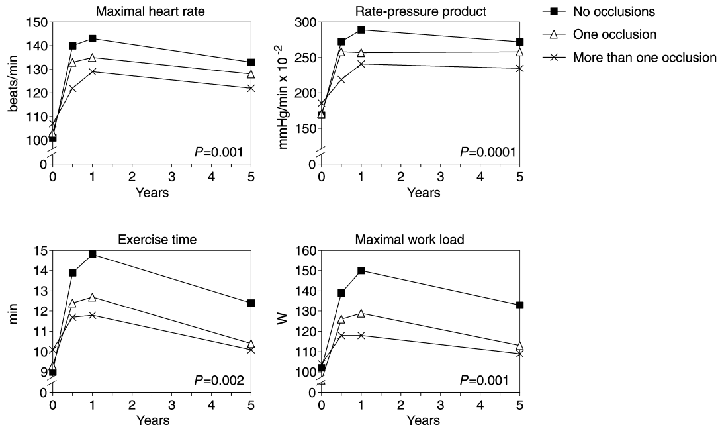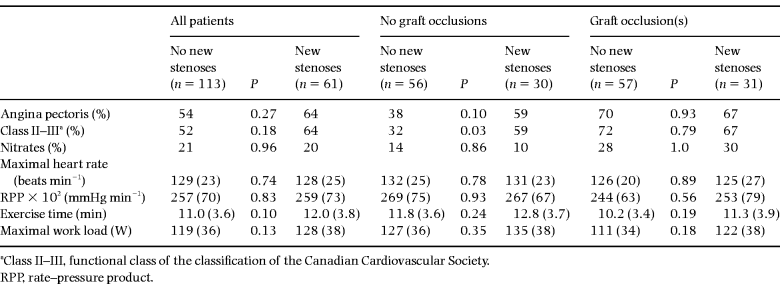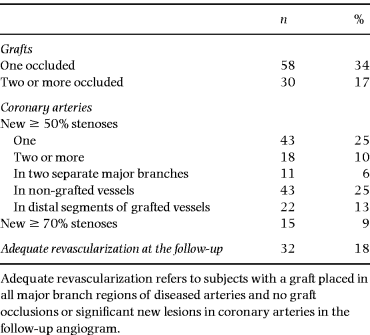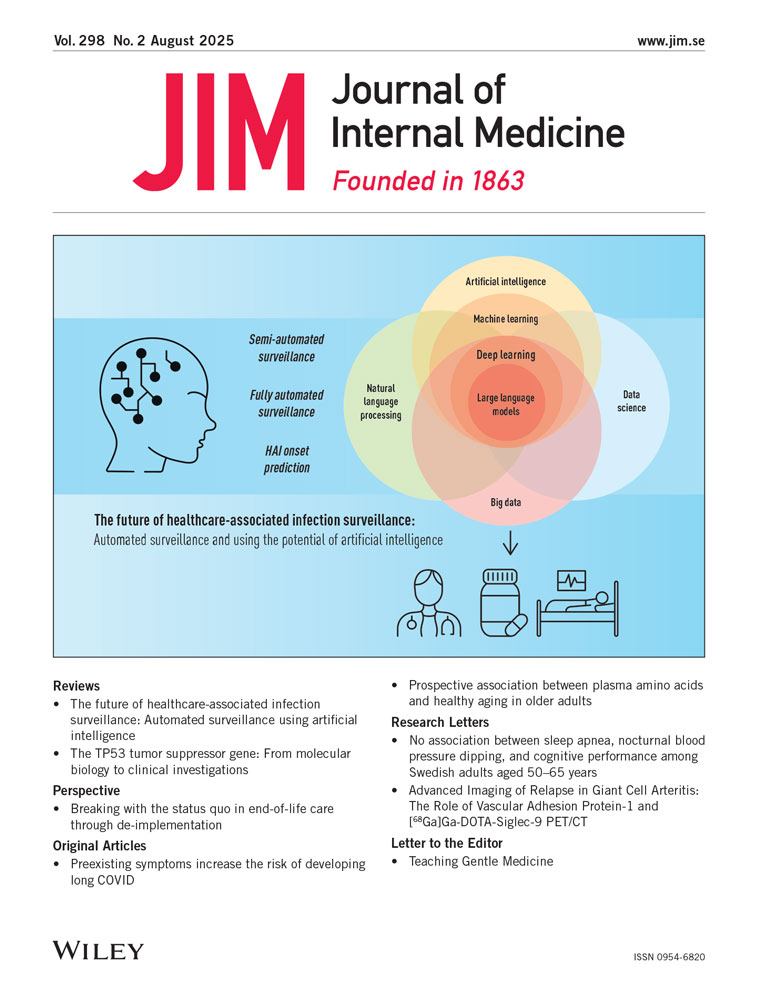Significance of graft occlusion and coronary atherosclerosis 5 years after coronary artery bypass grafting. A quantitative angiographic study with serial exercise testing
Abstract
Abstract. Korpilahti K, Engblom E, Hämäläinen H, Syvänne M, Hietanen E, Arstila M, Puukka P, Rönnemaa T (Central Hospital of Vaasa, Turku University Central Hospital, Research and Development Centre of the Social Insurance Institution, Turku and Helsinki University Central Hospital, Finland). Significance of graft occlusion and coronary atherosclerosis 5 years after coronary artery bypass grafting. A quantitative angiographic study with serial exercise testing. J Intern Med 1999; 245: 545–552.
Objective. To evaluate the relative importance of graft occlusions and progression of atherosclerosis in coronary arteries as causes of the occurrence of angina pectoris and impairment of physical performance 5 years after coronary artery bypass surgery.
Design. A 5-year follow-up study.
Setting. University hospital in south-western Finland.
Subjects. Altogether, 174 consecutive electively operated bypass patients.
Main outcome measures. Serial clinical evaluation and bicycle exercise tests (pre-operatively, at 6 months, and at 1 and 5 years). Quantitative coronary angiography pre-operatively and 5 years after the surgery.
Results. Subjects with patent grafts had fewer angina pectoris symptoms at the 5-year follow-up (24 vs. 52%, P = 0.001) and were treated less frequently with long-acting nitrates (3 vs. 15%, P = 0.037) than subjects with graft occlusions. Fewer of them were in classes II–III of the functional classification of the Canadian Cardiovascular Society (39 vs. 74%, P = 0.001). The exercise test was interrupted less often because of chest pain (23 vs. 41%, P = 0.03) and improvement in exercise test variables during the follow-up period was significantly greater in subjects with patent grafts (P < 0.002). Amongst patients without graft occlusions, those with new ≥ 50% diameter stenoses in coronary arteries were more often in functional classes II–III (59 vs. 32%, P = 0.03) than those without new stenoses, but the groups were similar with respect to angina pectoris and exercise tests variables. In patients with graft occlusions, those with and without new ≥ 50% diameter stenoses were similar with respect to functional class, angina pectoris and exercise test variables.
Conclusions. Angina pectoris and impairment of physical capacity 5 years after coronary artery bypass grafting are mainly due to occlusion of bypass grafts and not to progression of atherosclerosis in coronary arteries.
Introduction
Coronary artery bypass grafting (CABG) is effective in relieving angina pectoris and improving physical work capacity [1, 2]. Long-term alleviation of symptoms and signs of myocardial ischaemia is mainly attributed to sustained patency of bypass grafts [3–7] and the degree of revascularization [8–12], but the beneficial effect seems to diminish during the first 5 years after the operation [1, 2]. The main reason is believed to be the occlusion of the bypass grafts [9, 11], but it is not well established to what extent the recurrence of ischaemia is caused by progression of atherosclerosis in coronary arteries. Consequently, our purpose was to determine whether angina pectoris and low physical performance after the CABG are entirely explained by graft occlusions or whether stenoses of coronary arteries have a contributory role.
In previous studies, the assessment of coronary atherosclerosis has based on visual angiographic estimations. In the present study, we evaluated coronary stenoses using quantitative coronary angiography, which was performed pre-operatively and 5 years after CABG.
Methods
Subjects
The formation of the baseline study population has been described earlier [13]. Briefly, it included 228 consecutive patients undergoing elective CABG in Turku University Central Hospital between February 1986 and December 1987. The patients participated in a randomized controlled trial of cardiac rehabilitation. The programme and the results of rehabilitation have been reported elsewhere [14–16]. The patients were re-examined at 6 months, and at 1 and 5 years after the surgery. Of the 203 patients alive at 5 years, 198 participated in the follow-up examination and were offered a control coronary angiography. Of these patients, 18 refused and four had contraindications to coronary angiography. Thus, 176 subjects (87% of the cohort) had control coronary angiography. All angiographed subjects gave their verbal informed consent. The protocol was approved by the Joint Ethics Committee of Turku University and Turku University Central Hospital.
Ninety per cent of the subjects were men. The mean age (SD) at the time of the operation was 54 (6) years. Thirty-six per cent of the subjects had a history of myocardial infarction before the operation, and 8% had a perioperative myocardial infarction. Mean (SD) left ventricular ejection fraction before the operation was 71 (11)%. Ten per cent of the subjects had left main disease, 60% had triple-vessel disease, 32% had double-vessel disease and 8% had single-vessel disease. The aim of the surgery was to achieve adequate revascularization, i.e. the placement of grafts in all major branch regions of diseased arteries, but not necessarily grafting of every artery with a stenosis. The number of distal anastomoses was five in one subject, four in 27 subjects, three in 74 subjects, two in 60 subjects and one in 12 subjects. Average number of grafts subject–1 (SD) was 2.7 (0.9), and adequate revascularization was achieved in 109 (62%) subjects. Before the operation, 3% of subjects were in class I, 37% in class II, 58% in class III, and 2% in class IV according to the classification of the Canadian Cardiovascular Society [17]. The proportion of subjects treated with beta-blockers was 85% pre-operatively, and 50% at the 6-month, 44% at the 1-year, and 47% at the 5-year follow-ups.
Exercise stress test
A bicycle exercise stress test was carried out with an electrically braked ergometer pre-operatively and 6 months, 1 and 5 years after the operation. After a 3 min warm-up, cycling without friction, the exercise started and the workload was increased in increments of 10 W min–1. Cycling was continued until fatigue or occurrence of signs of myocardial ischaemia or other generally accepted interruption criteria [18]. Myocardial ischaemia was considered to be present if (i) the patient experienced typical angina pectoris symptoms of sufficient severity to interrupt the exercise or to be forced to take nitroglycerin; (ii) there was a ≥ 0.1 mV horizontal or descending ST-segment depression at 60 ms after the J point; or (iii) a systolic blood pressure decrease from the previous value was observed during exercise.
During the exercise, ECG was recorded continuously and blood pressure was measured every 2 min. The last workload was taken as maximal workload. The rate–pressure product was calculated as the product of maximal heart rate and systolic blood pressure. Maximal tolerated workload, exercise time and rate–pressure product without angina pectoris were taken as indicators of angina-free exercise tolerance.
Coronary angiography
Coronary angiography was performed, on average (SD), 61 (2) months (range 59–68) after the CABG. One subject was angiographed 39 months after the CABG because of angina pectoris, and the result of that examination was used. All other subjects underwent angiography according to the study protocol at the 5-year follow-up. Percutaneous femoral approach was used in catheterization. Simultaneous biplane angiograms of the left ventricle, the coronary arteries and the bypass grafts were obtained. Surgical records were reviewed and angiography of the ascending aorta was performed to facilitate selective catheterization of all patent grafts. A dose of 0.5 mg of sublingual nitroglycerin or 1.25 mg of lingual isosorbide dinitrate aerosol was administered to all subjects immediately before coronary angiography.
Analysis of the angiograms
Angiograms were analysed using validated quantitative coronary arteriography software, the Cardiovascular Measurement System (Medis, Nuenen, The Netherlands) [19], as described elsewhere in detail [20]. Progression of atherosclerosis was evaluated in grafted and non-grafted coronary arteries by comparing the 5-year follow-up angiograms with pre-operative ones. Patients having at least one arterial stenosis of ≥ 50% of the diameter which was not seen in the pre-operative angiogram were classified as subjects with new lesions. All other subjects were classified as subjects without new lesions. Subjects were also categorized according to the number of occlusions of bypass grafts. Subjects with one or more occluded grafts were classified as subjects with graft occlusions, and all the others as subjects without graft occlusions. Furthermore, the subjects were divided into subgroups of patients who were adequately revascularized and those who were partially revascularized. Adequate revascularization was considered to have been attained if a graft had been placed in all major branch regions of diseased arteries, no graft occlusion had occurred and no significant lesion had developed in the ungrafted coronary arteries or distal to the site of grafting in the arteries. In all other cases, the subjects were considered to be partially revascularized.
Of the 176 angiographed subjects, two were excluded from the analysis due to poor quality of the angiograms. Nineteen subjects with poor co-operation or with other than cardiorespiratory reasons for termination of the exercise stress test at any of the follow-ups were excluded from the analysis. Four additional subjects refused to perform the exercise stress test, and one subject was not able to perform it because of sequelae of a brain tumour operation. Subjects using digitalis or with bundle branch block in the ECG (n = 15) were excluded from the analyses of the ST segment. The number of subjects with complete exercise test data at all follow-ups was 131.
Statistical analyses
SAS computer software was used for data analysis. Comparisons of continuous variables were performed using Student’s t-test. The differences in the changes between the groups were compared by means of analysis of variance for repeated measurements. Categorical variables were tested using the chi-square test or Fisher’s exact test. Yates correction for continuity was used in fourfold tables. P-values below 0.05 were taken as evidence of statistical significance.
Results
General
Five (3%) subjects suffered acute myocardial infarction during the 5-year follow-up period. Severity of angina pectoris, physical performance in the exercise stress test and the prevalence of graft occlusion(s) and new ≥ 50% narrowings in coronary arteries in the follow-up coronary angiogram did not differ significantly between the subjects with acute myocardial infarction before the operation, perioperatively or during the follow-up (n = 83) and those without acute myocardial infarction (n = 61). At the 5-year follow-up, 76 subjects were in functional class I, 79 in class II, 19 in class III, and none in class IV. One subject had coronary angioplasty in two non-grafted coronary arteries during the follow-up period. The mean (SD) left ventricular ejection fraction was 64 (15)% at follow-up. Only 11 (6%) of the patients had new ≥ 50% stenoses in the region of two separate major branches of their coronary arteries. When patients with graft occlusions were excluded, there were only three patients with ≥ 50% stenoses in the grafts. Therefore, the stenosed grafts were not included in the analysis as a separate variable. The results of the 5-year follow-up angiographies are presented in detail in Table 1.
Subjects with new lesions in coronary arteries or occlusions in grafts were similar to those without these findings with respect to pre-operatively determined functional class, physical capacity or signs of myocardial ischaemia during the exercise stress test.
Graft status
Compared with the subjects with one or more graft occlusions, those with all grafts patent had a lower incidence of angina pectoris at the 5-year follow-up, belonged less frequently to functional classes II–III and were treated less frequently with long-acting nitrates ( Table 2). Moreover, subjects with at least one occluded graft terminated the exercise stress test more often because of chest pain (41 vs. 23%, P = 0.03). The various exercise stress test variables improved more in the group of subjects with patent grafts than in the group with graft occlusions during the follow-up ( Fig. 1). These effects of graft occlusions were graded: subjects with at least two graft occlusions showed the lowest values in the exercise test variables. The differences between the three groups were most evident at the 1-year follow-up. No differences were found between the three groups with respect to treatment with beta-blockers, treatment for hypertension or angina-free exercise tolerance. There was a trend towards higher prevalence of ischaemia seen in ECG during the exercise test in subjects with at least one graft occlusion (n = 74) as compared with subjects with patent grafts (n = 75) (27 vs. 16%, P = 0.15).


Mean values of maximal heart rate, rate–pressure product, exercise time and maximal workload in the exercise stress test in subjects without (▪, n = 65), subjects with one (▵, n = 42) and subjects with more than one (×, n = 24) graft occlusion. P-values refer to the difference in overall change from baseline between the groups.
New stenoses in coronary arteries
When compared with subjects having no new stenoses (n = 83) in coronary arteries, the subjects with new ≥ 50% stenoses (n = 61) showed a similar prevalence of angina pectoris symptoms, were similarly distributed in the functional classes, and terminated the exercise stress test equally often because of chest pain. Maximal heart rate, rate–pressure product, exercise time, maximal workload and angina-free exercise tolerance were also similar in these two groups ( Table 3). The results were similar when the cut-off point of significant stenosis was set at 70 instead of 50%.

When subjects with occlusion(s) of grafts were excluded, the subjects with new ≥ 50% stenoses (n = 29) were more often in functional classes II–III (59 vs. 32%, P = 0.03) than subjects without new stenoses (n = 56) at the 5-year follow-up. All other tested variables were similar between these two groups ( Table 3).
When corresponding analysis was performed in subjects with at least one occluded graft, no difference was observed in any of the variables between subjects with and those without new ≥ 50% stenoses in coronary arteries ( Table 3).
Degree of revascularization
Subjects with adequate revascularization at the 5-year follow-up had a lower incidence of angina pectoris (13 vs. 43%, P = 0.003) and were less often in the functional classes II–III (31 vs. 71%, P = 0.004) than subjects with partial revascularization (n = 142). The improvements in the exercise stress test variables were greater in subjects with adequate revascularization than in subjects with partial revascularization ( Fig. 2). The differences between the groups in exercise test variables were greatest at the 1-year follow-up, except for the rate–pressure product where the difference between the groups was greatest at 5 years. There were no differences between the subjects with and without adequate revascularization with respect to the prevalence of ischaemia seen in ECG during the exercise test, treatment with long-acting nitrates or beta-blockers, treatment for hypertension or angina-free exercise tolerance.

Mean values of maximal heart rate, rate–pressure product, exercise time and maximal workload in the exercise stress test in subjects with adequate (▪, n = 25) and subjects with partial (▵, n = 106) revascularization. Adequate revascularization refers to subjects with a graft placed in all major branch regions of diseased arteries and no graft occlusions or significant new lesions in coronary arteries found in the follow-up angiogram. Partial revascularization refers to all other subjects. P-values refer to the difference in overall change from baseline between the groups.
Discussion
In this prospective 5-year follow-up study with serial exercise tests and quantitatively analysed pre-operative and 5-year coronary angiograms, the subjects’ angina pectoris symptoms decreased and physical performance improved after coronary artery bypass surgery, as expected [1, 2]. The improvements were most marked at 1 year after the operation, and diminished thereafter. Correlation of the variables indicating either myocardial oxygen consumption (maximal heart rate, rate–pressure product) or physical capacity (exercise time, maximal workload) of the exercise stress test with the patency of the grafts and the degree of revascularization was clear, which was also expected.
Computerized quantitative coronary angiography is superior to visual estimation in the evaluation of progression of atherosclerosis in coronary arteries [21, 22]. To our knowledge, this method has not been used previously in order to compare the anatomical status of the coronary circulation with the clinical evaluation and physical capacity after CABG. Despite this very accurate analytical method, angina pectoris symptoms, physical capacity during the follow-up period and ischaemic ECG changes during the exercise were not associated with the progression of atherosclerotic disease in coronary arteries, even when studied in the subgroups of patients with and without graft occlusions. This is probably due to the fact that the prevalence of subjects with new significant stenoses in more than one major coronary artery branch was low, being only 6%. Later on, however, the situation may be different; for example, 10 years after the operation, the role of the progression of atherosclerosis in coronary arteries with respect to functional capacity may be more important. On the basis of previous studies [23, 24], it is expected that the development of clinically significant stenoses in grafts, coronary arteries and, to a smaller extent, graft occlusions will continue to increase in this patient material as well. This will most probably lead to an increase in the prevalence of angina pectoris and a decrease in the functional capacity, measured with either the functional classification or exercise testing, and a need for further revascularization procedures during the following 5–10 years. Therefore, the results of this study should not be interpreted as suggesting that prevention of atherosclerosis is not important during the first 5 years after the CABG, especially as it is known that the progression of atherosclerosis and the formation of new lesions in coronary arteries can be halted or regression achieved with pharmacological or surgical (ileal bypass) intervention to lower serum cholesterol or low-density lipoprotein cholesterol [25–28].
There was a trend towards a higher prevalence of ischaemic changes in the ECG during the exercise test in subjects with graft occlusions than in those without, but the differences did not reach statistical significance. This lack of significance may be partly due to the small number of subjects with diagnostic ST depressions in this population. The fact that the subjects’ anti-ischaemic medication was not interrupted before the exercise test may also have had a diminishing effect on the prevalence of ST depressions in the ECG during the exercise test. The high incidence of normal exercise test ECGs in the presence of residual coronary disease after CABG has been recognized before [7], and it limits the usefulness of the exercise stress test in the evaluation of individual patients postoperatively. The exercise stress test ECG is also known to be relatively insensitive in detecting significant changes in the case of a single-vessel coronary artery disease [29].
The clinical evaluation of patients with recurring angina pectoris after CABG is difficult. Only 50% of our subjects with angina pectoris had graft occlusions, and 43% had partial revascularization at the 5-year follow-up. On the other hand, ischaemia during the exercise was diagnosed in 22% of subjects with graft occlusions and in 24% of subjects with partial revascularization. Therefore, the use of these measures to select patients for repeated revascularization seems too inaccurate. Of the non-invasive methods of detecting myocardial ischaemia, serial myocardial perfusion scintigraphy with thallium-201 has been shown to have an overall accuracy of 86% in detecting graft patency [30], but it is not possible to use serial isotope exercise testing in every CABG patient. So far, no good practical non-invasive methods seem to be available to assist the clinician in decision-making in this context, although exercise time and maximal workload in the exercise stress test near pre-operative levels may suggest graft occlusions.
In conclusion, the results of this study indicate that graft occlusion is the main reason for the presence of angina pectoris symptoms and impaired physical performance measured by exercise stress testing 5 years after the CABG. The progression of atherosclerosis in coronary arteries is too slow to produce clinically important stenoses within the 5-year period after the CABG.
Acknowledgements
This work was financially supported by the University Foundation of the University of Turku, Finland.
References
Received 25 May 1998; accepted 8 September 1998.





